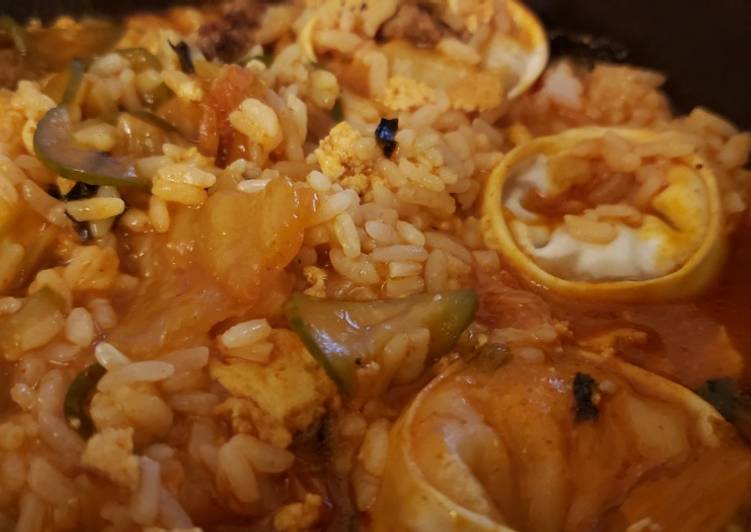Kimchi Stew. The difference between kimchi soup and kimchi stew. Kimchi stew is thicker than kimchi soup. Kimchi soup is less salty than kimchi stew.
 The ultra comforting Korean stew - Kimchi Jjigae recipe!
Kimchi Jjigae (김치찌개) also known as Kimchi stew or Kimchi soup is probably the most common way of consuming some aged Kimchi.
It is a such a staple food in Korean households that typically Koreans would eat it at least once or twice a week if Kimchi stew, or kimchi jigae, is a fiery red stew served in a served in a stone pot.
You can cook Kimchi Stew using 11 ingredients and 6 steps. Here is how you achieve it.
The ultra comforting Korean stew - Kimchi Jjigae recipe!
Kimchi Jjigae (김치찌개) also known as Kimchi stew or Kimchi soup is probably the most common way of consuming some aged Kimchi.
It is a such a staple food in Korean households that typically Koreans would eat it at least once or twice a week if Kimchi stew, or kimchi jigae, is a fiery red stew served in a served in a stone pot.
You can cook Kimchi Stew using 11 ingredients and 6 steps. Here is how you achieve it.
Ingredients of Kimchi Stew
- It's 1/2 C. of Napa Kimchi (range from 1/4-1 cup), Chopped.
- Prepare 2 Tbsp. of Gochujang Paste (Add more or less for spice.).
- It's 1 C. of Chicken Broth (Add Salt if Unsalted).
- Prepare 2 C. of Water (Ratio can be changed with Chicken Broth).
- You need 1 Tsp. of Gochujang Powder (Add more or less for spice.).
- Prepare 1/2 of lbs. Hot Italian Sausage, Seared, then Cube.
- You need 1 of Mini Seedless Cucumber, Thinly Sliced (Optional).
- Prepare 1/4 C. of Enoki Mushrooms, Diced (Optional).
- You need 1/2 C. of Beansprouts (Optional).
- You need 4 of Dumplings (Kimchi Dumplings- Optional).
- It's 1 C. of White Rice.
Use store-bought broth, add tofu and a protein to make this at home!. When kimchi gets old, it becomes an excellent ingredient for various other dishes! The most common dish made with aged kimchi is kimchi jjigae (김치 찌개). It's a go-to stew in Korean homes.
Kimchi Stew instructions
- Start your 1 Cup of White rice and then prepare all your ingredients. I normally chop all my veggies and then flatten out my sausage into a long thin (1/2 inch or less) slice. But you could cube it up on this step instead of later..
- Heat up your water and broth in one pot, and start up a pan to sear your sausage. Prioritize your sausage. Brown both sides and then let it rest, it doesn't need to be cooked through since we'll be boiling it in the stew next..
- I normally use the sliced cucumbers here as the pan is cooling off to absorb some of the flavors, then add then into the stew in the next step..
- When the pot is hot, add in your Gochujang paste and chopped kimchi. Mix, then let it rise to a boil. Once Boiling, add in your sausage (chopped, letting it rest should've made it nearly done.), then all your other ingredients..
- I let my stew boil till my rice is done, so you might need to prep sooner or later based on its average cook time. My stew is usually boiling/simmering for about 15-20 minutes..
- Depending on the flavors you might want present, you might want to hold some ingredients till the last five minutes to preserve more of their taste..
Growing up in Korea, we had a lot of meals just with kimchi jjigae and a bowl of rice. I don't remember ever getting tired of it. Kimchi Stew is one of the most loved dishes in Korea. Even when you don't have much appetite, this is sure to fix it. You'll have no problem finishing a big bowl of rice with Kimchi Stew!